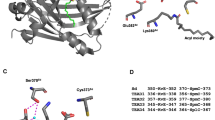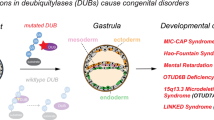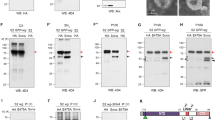Abstract
The precise regulation of growth factor signalling is crucial to the molecular control of development in Drosophila. Post-translational modification of signalling molecules is one of the mechanisms that modulate developmental signalling specificity. We describe a new gene, fringe connection (frc), that encodes a nucleotide–sugar transporter that transfers UDP–glucuronic acid, UDP–N-acetylglucosamine and possibly UDP–xylose from the cytoplasm into the lumen of the endoplasmic reticulum/Golgi. Embryos with the frc mutation display defects in Wingless, Hedgehog and fibroblast growth factor signalling. Clonal analysis shows that fringe-dependent Notch signalling is disrupted in frc mutant tissue.
This is a preview of subscription content, access via your institution
Access options
Subscribe to this journal
Receive 12 print issues and online access
$209.00 per year
only $17.42 per issue
Buy this article
- Purchase on Springer Link
- Instant access to full article PDF
Prices may be subject to local taxes which are calculated during checkout






Similar content being viewed by others
References
Binari, R. C. et al. Genetic evidence that heparin-like glycosaminoglycans are involved in wingless signaling. Development 124, 2623–2632 (1997).
Haerry, T. E., Heslip, T. R., Marsh, J. L. & O'Connor, M. B. Defects in glucuronate biosynthesis disrupt Wingless signaling in Drosophila. Development 124, 3055–3064 (1997).
Hacker, U., Lin, X. & Perrimon, N. The Drosophila sugarless gene modulates Wingless signaling and encodes an enzyme involved in polysaccharide biosynthesis. Development 124, 3565–3573 (1997).
Lin, X. & Perrimon, N. Dally cooperates with Drosophila Frizzled 2 to transduce Wingless signalling. Nature 400, 281–284 (1999).
Tsuda, M. et al. The cell-surface proteoglycan Dally regulates Wingless signalling in Drosophila. Nature 400, 276–280 (1999).
Lin, X., Buff, E. M., Perrimon, N. & Michelson, A. M. Heparan sulfate proteoglycans are essential for FGF receptor signaling during Drosophila embryonic development. Development 126, 3715–3723 (1999).
The, I., Bellaiche, Y. & Perrimon, N. Hedgehog movement is regulated through tout velu-dependent synthesis of a heparan sulfate proteoglycan. Mol. Cell 4, 633–639 (1999).
Bellaiche, Y., The, I. & Perrimon, N. Tout-velu is a Drosophila homologue of the putative tumour suppressor EXT-1 and is needed for Hh diffusion. Nature 394, 85–88 (1998).
Lind, T., Tufaro, F., McCormick, C., Lindahl, U. & Lidholt, K. The putative tumor suppressors EXT1 and EXT2 are glycosyltransferases required for the biosynthesis of heparan sulfate. J. Biol. Chem. 273, 26265–26268 (1998).
Perrimon, N. & Bernfield, M. Specificities of heparan sulfate proteoglycans in developmental processes. Nature 404, 725–729 (2000).
Irvine, K. D. Fringe, Notch, and making developmental boundaries. Curr. Opin. Genet. Dev. 9, 434–441 (1999).
Moloney, D. J. et al. Fringe is a glycosyltransferase that modifies Notch. Nature 406, 369–375 (2000).
Bruckner, K., Perez, L., Clausen, H. & Cohen, S. Glycosyltransferase activity of Fringe modulates Notch–Delta interactions. Nature 406, 411–415 (2000).
Panin, V. M., Papayannopoulos, V., Wilson, R. & Irvine, K. D. Fringe modulates Notch–ligand interactions. Nature 387, 908–912 (1997).
Klein, T. & Arias, A. M. Interactions among Delta, Serrate and Fringe modulate Notch activity during Drosophila wing development. Development 125, 2951–2962 (1998).
Perrimon, N., Lanjuin, A., Arnold, C. & Noll, E. Zygotic lethal mutations with maternal effect phenotypes in Drosophila melanogaster. II. Loci on the second and third chromosomes identified by P-element-induced mutations. Genetics 144, 1681–1692 (1996).
Perrimon, N. The genetic basis of patterned baldness in Drosophila. Cell 76, 781–784 (1994).
DiNardo, S., Sher, E., Heemskerk-Jongens, J., Kassis, J. A. & O'Farrell, P. H. Two-tiered regulation of spatially patterned engrailed gene expression during Drosophila embryogenesis. Nature 332, 604–609 (1988).
Yoffe, K. B., Manoukian, A. S., Wilder, E. L., Brand, A. H. & Perrimon, N. Evidence for engrailed-independent wingless autoregulation in Drosophila. Dev. Biol. 170, 636–650 (1995).
Beiman, M., Shilo, B. Z. & Volk, T. Heartless, a Drosophila FGF receptor homolog, is essential for cell migration and establishment of several mesodermal lineages. Genes Dev. 10, 2993–3002 (1996).
Gisselbrecht, S., Skeath, J. B., Doe, C. Q. & Michelson, A. M. heartless encodes a fibroblast growth factor receptor (DFR1/DFGF-R2) involved in the directional migration of early mesodermal cells in the Drosophila embryo. Genes Dev. 10, 3003–3017 (1996).
Herman, T. & Horvitz, H. R. Three proteins involved in Caenorhabditis elegans vulval invagination are similar to components of a glycosylation pathway. Proc. Natl Acad. Sci. USA 96, 974–979 (1999).
Herman, T., Hartwieg, E. & Horvitz, H. R. sqv mutants of Caenorhabditis elegans are defective in vulval epithelial invagination. Proc. Natl Acad. Sci. USA 96, 968–973 (1999).
Ma, D., Russell, D. G., Beverley, S. M. & Turco, S. J. Golgi GDP–mannose uptake requires Leishmania LPG2. A member of a eukaryotic family of putative nucleotide–sugar transporters. J. Biol. Chem. 272, 3799–3805 (1997).
Hong, K., Ma, D., Beverley, S. M. & Turco, S. J. The Leishmania GDP–mannose transporter is an autonomous, multi-specific, hexameric complex of LPG2 subunits. Biochemistry 39, 2013–2022 (2000).
Berninsone, P., Hwang, H. Y., Zemtseva, I., Horvitz, H. R. & Hirschberg, C. B. SQV-7, a protein involved in Caenorhabditis elegans epithelial invagination and early embryogenesis, transports UDP–glucuronic acid, UDP–N-acetylgalactosamine, and UDP–galactose. Proc. Natl Acad. Sci. USA 98, 3738–3743 (2001).
Abeijon, C., Mandon, E. C. & Hirschberg, C. B. Transporters of nucleotide sugars, nucleotide sulfate and ATP in the Golgi apparatus. Trends Biochem. Sci. 22, 203–207 (1997).
Khare, N. & Baumgartner, S. Dally-like protein, a new Drosophila glypican with expression overlapping with wingless. Mech. Dev. 99, 199–202 (2000).
Baeg, G. H., Lin, X., Khare, N., Baumgartner, S. & Perrimon, N. Heparan sulfate proteoglycans are critical for the organization of the extracellular distribution of Wingless. Development 128, 87–94 (2001).
de Celis, J. F., Tyler, D. M., de Celis, J. & Bray, S. J. Notch signalling mediates segmentation of the Drosophila leg. Development 125, 4617–4626 (1998).
Rauskolb, C. & Irvine, K. D. Notch-mediated segmentation and growth control of the Drosophila leg. Dev. Biol. 210, 339–350 (1999).
Irvine, K. D. & Wieschaus, E. Fringe, a boundary-specific signaling molecule, mediates interactions between dorsal and ventral cells during Drosophila wing development. Cell 79, 595–606 (1994).
Kim, J., Irvine, K. D. & Carroll, S. B. Cell recognition, signal induction, and symmetrical gene activation at the dorsal–ventral boundary of the developing Drosophila wing. Cell 82, 795–802 (1995).
Yuan, Y. P., Schultz, J., Mlodzik, M. & Bork, P. Secreted fringe-like signaling molecules may be glycosyltransferases. Cell 88, 9–11 (1997).
Moloney, D. J. et al. Mammalian Notch1 is modified with two unusual forms of O-linked glycosylation found on epidermal growth factor-like modules. J. Biol. Chem. 275, 9604–9611 (2000).
Foster, G. G. Negative complementation at the notch locus of Drosophila melanogaster. Genetics 81, 99–120 (1975).
Portin, P. Allelic negative complementation at the Abruptex locus of Drosophila melanogaster. Genetics 81, 121–133 (1975).
Munro, S. & Freeman, M. The notch signalling regulator fringe acts in the Golgi apparatus and requires the glycosyltransferase signature motif DXD. Curr. Biol. 10, 813–820 (2000).
Laufer, E. et al. Expression of Radical fringe in limb-bud ectoderm regulates apical ectodermal ridge formation. Nature 386, 366–373 (1997).
Rodriguez-Esteban, C. et al. Radical fringe positions the apical ectodermal ridge at the dorsoventral boundary of the vertebrate limb. Nature 386, 360–366 (1997).
Zhang, N. & Gridley, T. Defects in somite formation in Lunatic fringe-deficient mice. Nature 394, 374–377 (1998).
Evrard, Y. A., Lun, Y., Aulehla, A., Gan, L. & Johnson, R. L. Lunatic fringe is an essential mediator of somite segmentation and patterning. Nature 394, 377–381 (1998).
Spradling, A. C. et al. Gene disruptions using P transposable elements: an integral component of the Drosophila genome project. Proc. Natl Acad. Sci. USA 92, 10824–10830 (1995).
Wilder, E. L. & Perrimon, N. Dual functions of wingless in the Drosophila leg imaginal disc. Development 121, 477–488 (1995).
Ingham, P. W. & Fietz, M. J. Quantitative effects of hedgehog and decapentaplegic activity on the patterning of the Drosophila wing. Curr. Biol. 5, 432–440 (1995).
Ito, K., Awano, W., Suzuki, K., Hiromi, Y. & Yamamoto, D. The Drosophila mushroom body is a quadruple structure of clonal units each of which contains a virtually identical set of neurones and glial cells. Development 124, 761–771 (1997).
Duffy, J. B., Harrison, D. A. & Perrimon, N. Identifying loci required for follicular patterning using directed mosaics. Development 125, 2263–2271 (1998).
Guo, Y. C. & Conrad, H. E. The disaccharide composition of heparins and heparan sulfates. Anal. Biochem. 176, 96–104 (1989).
Goud, B., Salminen, A., Walworth, N. C. & Novick, P. J. A GTP-binding protein required for secretion rapidly associates with secretory vesicles and the plasma membrane in yeast. Cell 53, 753–768 (1988).
Adams, M. D. et al. The genome sequence of Drosophila melanogaster. Science 287, 2185–2195 (2000).
Goto, S. et al. UDP–sugar transporter implicated in glycosylation and processing of Notch. Nature Cell Biol. 3, 816–822 (2001).
Acknowledgements
We thank M. Zeidler, B. Stronach and K. Brückner for comments on the manuscript, and C. Hirschberg, C. Abeijon, P. Berninsone, S. Cherry, K. Nybakken and I. The for helpful discussions. Special thanks to K. Irvine, S. Artananis-Tsakonas and J. de Celis for stocks, S. Baumgartner for the Dally-like antibody, H. Agaisse for help with the northern analysis, and C. Hartmann for performing the plasmid rescue experiments. N.P. is an Investigator of the Howard Hughes Medical Institute. This work was supported by NIH Grant AI31078 (S.J.T. and S.M.B.) and GM61110 (N.P.), as well as HFSP (N.P.).
Author information
Authors and Affiliations
Corresponding author
Rights and permissions
About this article
Cite this article
Selva, E., Hong, K., Baeg, GH. et al. Dual role of the fringe connection gene in both heparan sulphate and fringe-dependent signalling events. Nat Cell Biol 3, 809–815 (2001). https://doi.org/10.1038/ncb0901-809
Received:
Revised:
Accepted:
Published:
Issue Date:
DOI: https://doi.org/10.1038/ncb0901-809
This article is cited by
-
In silico analysis of the fucosylation-associated genome of the human blood fluke Schistosoma mansoni: cloning and characterization of the enzymes involved in GDP-L-fucose synthesis and Golgi import
Parasites & Vectors (2013)
-
Meigo governs dendrite targeting specificity by modulating Ephrin level and N-glycosylation
Nature Neuroscience (2013)
-
Molecular cloning, phylogenetic analysis, and expression profiling of a grape CMP-sialic acid transporter-like gene induced by phytohormone and abiotic stress
Genes & Genomics (2013)
-
Developmental diseases caused by impaired nucleotide sugar transporters
Glycoconjugate Journal (2013)
-
Neurogenetics and Pharmacology of Learning, Motivation, and Cognition
Neuropsychopharmacology (2011)



